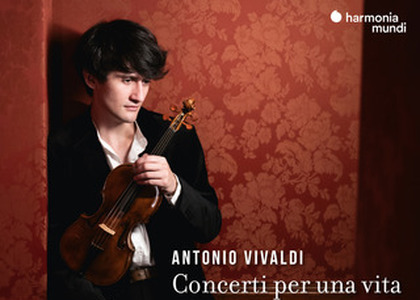Disk of 2024

Violinist Théotime Langlois de Swarte and "Le Consort" - album "Antonio Vivaldi - Concerti per una vita" - CD Review, 16th of May 2024
Giovanni Legrenzi - Aria ''Occhi miei si dormire'' from the opera "La divisione del Mondo" (world premiere recording), Antonio Vivaldi - Concerto RV 813 in D minor, Ciaccona in B flat major from Concerto RV 370, (world premiere recording), Concerto RV 315 in G minor "Vara" - Genova version, Concerto RV 171 in C major "per S.M.C.C.", Concerto RV 250 in E flat major (world premiere recording).
Violinist Théotime Langlois de Swarte and "Le Consort" - album "Antonio Vivaldi - Concerti per una vita" - CD Review, 16th of May 2024
With a world premiere recording begins violinist Théotime Langlois de Swarte's latest double album - the aria ''Occhi miei si dormire'' from Giovanni Legrenzi's opera "La divisione del Mondo", precisely to provide a sonic profile of the world in which Antonio Vivaldi was born, or an introduction preparing a fragment of a Symphony suggesting the earthquake that would have occurred, according to legend at the moment Vivaldi was born. Quite original this opening image proposed by the French violinist, for his new album dedicated to Antonio Vivaldi under the title "Concerti per una vita" - a release under the Harmonia Mundi label from February 16th - Théotime Langlois de Swarte seconded by "Le Consort", an ensemble he founded in 2015, to explore the repertoire of the 17th and 18th centuries, imposing its lines and conduct in performance.
This is not the first time I have presented a Théotime Langlois de Swarte album. We remember "The mad lover" with pages from 17th century England, also the album "Vivaldi, Locatelli, Leclair", recorded with the ensemble "Les Ombre". In other words, any new release by this brilliant French violinist is an event for all lovers of early music, both in terms of the quality of the interpretation and the conception of the material. There are countless surprises in this new album, countless concertos, or excerpts from concerts recorded for the first time in the world, arias adapted to the violin register, material of a richness and freshness that is easy to perceive even on first hearing.
Vivaldi was decisive in my passion for the violin," says Théotime Langlois de Swarte in the album presentation. "As a child I listened to him endlessly. It was a revelation, both as repertoire and as this type of baroque violin. The concerto writing exerted an absolute attraction on me. What thrills me in this music is the virtuosity and inventiveness of the solos. Vivaldi has this incredible force in which he impresses a character from the start, like an opera aria in which the first few seconds are enough to capture the whole essence; also the vocality of the slow movements - an economy of means often achieved with repetitive notes above which a melodic line of intense emotional force unfolds. The relationship between this highly tonal virtuosity and the almost eternal character of the slow movements represents a first apogee of the violin and, at the same time, a new birth."
Violinist Théotime Langlois de Swarte's commentary continues in the same vein. We discover the passion and skill with which he flies through these pages, proposing to construct a sound through which he has the possibility to express the instrument's vocality, the common evolution of the vocal and instrumental repertoire.
As a particular note, there is a search for the original sound, for the essence of this music. The artist plays on a Jacob Stainer violin from 1665, and it is known that at the Ospedale della Pietà there was at least one similar instrument in Vivaldi's time. Meeting the musicologist Olivier Fourés encourages Théotime Langlois de Swarte to decipher lesser-known aspects of Vivaldi's writing, to present the different characters of each concert, and above all their diversity, the variety of effects, colours and compositional procedures revealing this Vivaldian language. Important for the artist, though very difficult, is the setting of each concert in its historical context, giving it "a particular colour according to the person or occasion for whom it was composed". Of course time does not allow for such detail, we retain the conclusion - "for one of the best known composers of Western music it is amazing to find that there are always facets that can be explored, as this album attempts to do". We note the sonic quality, freshness and breadth of this new project which we will certainly return to again , keeping it undoubtedly among the favourites of this recording year.














